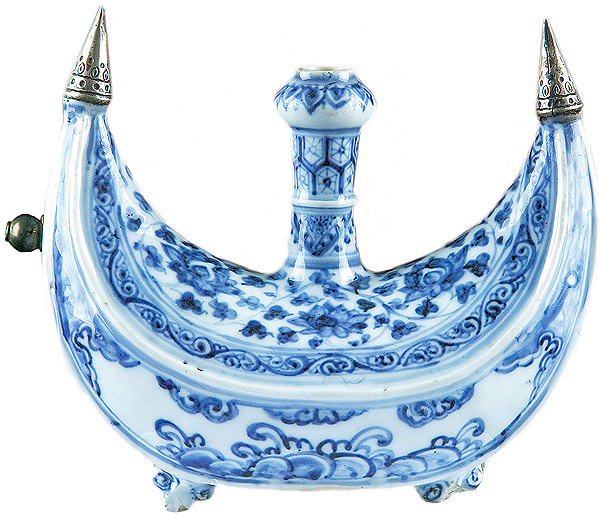
“The Frog-shaped Kendi” (Figure 1.) was made in China, early 17th century. The porcelain is paired with 19th-century Turkish silver mounts. [1] Kendis are a well-known form in the Southeast Asian repertoire of vessels, and it has played an important role in daily life and rituals of the region since ancient times. The word Kendi is a Malay word coming from the Sanskrit kundika (water pot) and indicating a ceremonial vessel used for ritual cleansing and drinking. [2] Structurally, a typical Kendi has a bulbous body, vertical filling neck which also serves as a handle, and a narrow spout. It is created so that water could be poured out without the sprout coming in contact with the drinker’s lips, thereby avoiding contamination. [3]
Diversity of Kendis
Kendis come in many different shapes and designs, they were made throughout Southeast Asia. Apart from its utilitarian purpose as a water container, they were often used in rituals as pouring vessels in wedding and various ceremonies. For instance, in Bali, a bride signified submission to her husband by pouring water over his feet with a Kendi. [4] The Khmers considered Kendi essential for Hindu rituals of pouring sacred waters over the King at his coronation. [5] The Khmer and Thai favoured Kendi in zoomorphic forms, such as ducks and geese; the Vietnamese made some shaped like elephants and storks. [6] These examples just go to show that not all Kendis are made for the same function or purpose, it changes according to the different cultures. The stylistic differences could also suggest that these Kendis were part of the lively international trade in ceramics wares.
Cross-cultural Elements
It is interesting to see the cross-cultural encounter between China and Turkey in “The Frog-shaped Kendi”. The iconic blue-and-white porcelain is modelled in a form of crouching frog. In Chinese traditional culture, the frog is associated with healing and good fortune in business. [7] On a closer look, floral motif such as tulip and carnation can be seen on the silver mount, it connotes Turkey, particularly the Ottoman Empire. Flowers has manifested itself in almost every aspect of arts in the Ottoman court. The elite and high-class society of the Ottoman Period had an immense love for the tulip as it symbolises nobility and privilege. [8] Therefore, the rarity of the material such as porcelain and silver coupled with symbolic motifs on “The Frog-shaped Kendi” implies that it was meant for someone of a high status or the royals.

Other Types of Kendis
On a material level, the “Hookah base in the form of an elephant” (Figure 2.) seems to share the similar materials used in “The Frog-shaped Kendi” but it is not used as a storage vessel.
The term “Hookah” means it is an oriental smoking device with a tube connected to a container where the smoke is cooled by passing through water. [9] (In modern day context, it is known as “Shisha”) This elephant kendi has a trunk that is made of silver, it has an opening for the smoking tube and a tobacco burner perched on the elephant’s back.
Another notable example of Kendi that uses Silver and Porcelain would be this “Crescent-shaped Kendi” (Figure 3.), it was made in the 15th century Ming Dynasty. [10] The graceful shape of this Kendi is said to imitate the bronze water containers of Persia and Mughal India. [11] The crescent moon form of this Kendi would have had great symbolic appeal to the people in the Islamic societies. The moon plays an important role in Islam because the date of Ramadan is determined through the use of a lunar Islamic calendar. [12] Furthermore, the crescent moon (also known as Hilal) defines the start and end of Islamic months. The need to decide the precise time of the appearance of the crescent moon was one of the lead for Muslims to study astronomy. [13]

All in all, Kendis played an interesting role in cross-cultural exchange, different themes, functions, styles, shapes were interpreted freely. At a glance, people usually think Kendis are merely used to store liquid or act as a decorative container but there is so much more to it than that — the different forms, materials, the symbols. Potters around the world have reimagined and manipulated Kendis into various artistic forms to appeal to a certain cultural group or win customers.
Bibliography
[1] Area360 Inc. Frog-Shaped Kendi – Asian Civilisations Museum. Accessed October 25, 2018. https://discover.acm.stqry.com/v/frog-shaped-kendi/s/5db71c52-8935-47ba-a31e-8703a4f7713a.
[2] “Kendi.” Www.roots.sg. Accessed October 25, 2018. https://roots.sg/learn/collections/listing/1098531.
[3] Ibid
[4] Finlay, Robert. The Pilgrim Art: Cultures of Porcelain in World History. Berkeley: University of California Press, 2010.
[5] Ibid
[6] Ibid
[7] Cooper, J. C. Symbolic & Mythological Animals. Hammersmith, London: Aquarian Press, 1992.
[8] Pembecioğlu, Nilüfer. Narratives through Turkish Perspective: Transmedia Storytelling and Intertextuality Examples in the Postnetwork Era. Cluj-Napoca: Argonaut, 2014.
[9] “Hookah.” Dictionary.com. Accessed October 25, 2018. https://www.dictionary.com/browse/hookah.
[10] National Gallery of Australia. Crescent Moon. Accessed October 25, 2018. https://nga.gov.au/crescentmoon/details/kendi.cfm.
[11] Ibid
[12] “Eid: How Is the Start of the Muslim Festival Determined?” BBC News. June 24, 2017. Accessed October 25, 2018. https://www.bbc.com/news/explainers-40394103.
[13] Ibid
Image Sources
Figure 1: “Frog-Shaped Kendi.” Digital image. Accessed October 25, 2018. https://i.stqry.com/1200×1200/12/125cd67a-234b-473c-96a5-e64fa906b6ba.jpg.
Figure 2: “Hookah Base in the Form of an Elephant.” Digital image. Accessed October 25, 2018. https://i.stqry.com/1200×1200/3d/3d441782-97a5-49f5-98a1-c986a468e454.jpg.
Figure 3: “Crescent Moon.” Digital image. Accessed October 25, 2018. https://nga.gov.au/crescentmoon/images/large/kendi.jpg.


What a marvelous group of kendis you have discovered to compare and learn from! I can totally see now why the spout needs to be thin if we aren’t supposed to put are lips on the spout. But, as you say, these objects are also used for Buddhist & Hindu rituals–to pour water. So, why are they in different animal shapes? When was the metalwork added? This too like the blue jars were made at two different stages then. Nice analysis of the motifs that then link to the possible patron.